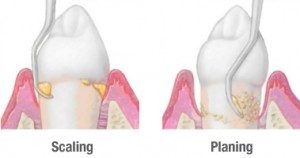The two most common oral care problems people hear about are Plaque and Tartar. While they are related, they are both very different maladies that need different kinds of treatment.
Plaque
Plaque is a sticky, colorless, soft substance that builds up around the gum line. Plaque is film of bacteria made up of food particles and saliva, and it collects on your teeth every day. Plaque hurts your teeth and gums because it can cause cavities, periodontal disease, and gingivitis, and it can harden into Tartar if it isn’t removed each day.
Plaque causes cavities because of the acid contained within it. It attacks your teeth enamel after you eat, and if it does this long enough without being cleaned, it can break through the enamel, giving the cavity a place to take hold. Plaque also irritates the gums – if your gums bleed when you brush or floss, this could be because of plaque. If you don’t take care of this, the gums will pull away from your teeth, which may cause you to lose a tooth.
Luckily, Plaque can most easily be removed with daily brushing, flossing, and rinsing. Plaque forms within eight hours, so make sure you brush before bed, too.
Tartar
Tartar is yellow or yellowish brown. It’s hard, porous and crusty. It can be very unsightly, and forms along the gum line. Tartar is made up of hardened plaque that hasn’t been brushed away. It is hard because it comes from the mineral deposits in saliva.
Tartar is harmful because it’s hard and porous – bacteria build up inside the tartar on your teeth. It also causes cavities, gum disease, and tooth loss. If tartar isn’t removed it will continue to grow and calcify.
Tartar is not as easily removed as plaque. It can only be done professionally, by a dentist. Tartar is removed by scaling it – instruments are used to remove tartar from teeth. If the tartar has formed below the gum line, then you may have to get surgery to remove it. The best way to prevent all of this is through vigilant brushing and flossing. Tartar control toothpaste has also been shown to help.



